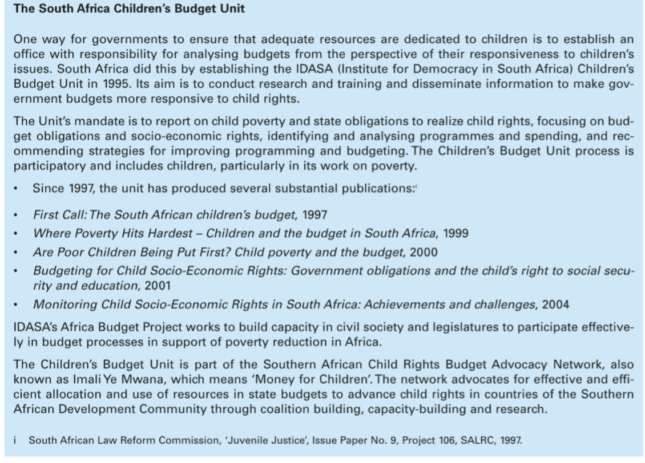Coordination and management of children’s rights legislative reform process
Contents- Incorporation
- Key elements of children’s rights legislative reform
-
Coordination and management of children’s rights legislative reform process
- Drafting legislation
- Identifying the coordinator
- Budgeting for the legislative reform
- Setting a timeline
- Ensuring a participatory and inclusive process – consultations
- Setting up a feedback system
- Affirming government commitment at all stages
- Potential general barriers when engaging in children’s rights legislative reform
- Child Rights Impact Assessments (CRIA) – Ex ante
- Non-legal measures to support incorporation of children’s rights
Budgeting for the legislative reform
- The national budget is the financial embodiment of a government’s policy and legislative goals. Consequently, law- and policymaking should be intimately related with the budgetary process.
- Legislative reform and the subsequent implementation of legislation through policies and institutional development require an adequate allocation of funds from governments. And governments should be held accountable in this regard (see also OHCHR 2017)
- The need for funding for legislative reform is highlighted by the CRC Committee (CRC GC 19), which views adequate funding (budget allocation) as necessary to realise children’s rights and incorporate the CRC into the domestic legal system. See also, The States
- Without sufficient allocation of resources, there will be significant obstacles to the implementation of legislation.
E.g.: Jamaica enacted a Child Care and Protection Act in 2004. The new Act aimed at protecting the child in all spheres of life and promoting a caring environment to give each child an equal footing in society. However, there were general concerns regarding funding to sustain and implement the provisions of the new Act. Some specific obstacles included:
- Insufficient funding to sustain the training and educational programme to change the national mind‐set about the importance of protecting children;
- Insufficient funding to ensure that the mechanisms and institutions function as proposed;
- Insufficient funding for day‐to‐day logistics, such as vehicles and fuel to transport children from centres to court.
E.g.: In South Africa the Public Finance Manage Act No 1 of 1999 requires costing of proposed legislation. See below for more information.


When allocating public budgets to undertake children’s rights legislative reform, States should ensure that their decision-making is effective, efficient, equitable, transparent and sustainable (General Comment No. 19). The below guidance has been adapted to meet the obligations in the context of children’s rights legislative reform:
- Effectiveness: the budget decision should be constantly assessed to ensure the best possible outcomes for children (through legislative reform among other methods while paying special attention to children in vulnerable situations (CRC GC 19, para. 59)
- Efficiency: public resources and programmes for the children’s rights legislative reform should be applied in such a way as to ensure value for money and bearing in mind the obligation to respect, protect and fulfil children’s rights (CRC GC 19, para. 60)
- Equity: the principle of non-discrimination should be upheld, to ensure that the legislative reform process leads to substantive equality among children (CRC GC 19, para. 61)
- Transparency: the public finance system for the reform should be open to scrutiny. This helps combat corruption and maladministration, which in turn increases the budget available for children’s rights advancement. States Parties should actively promote access to information about public revenues, allocations and spending related to children and adopting policies to support and encourage continuous engagement with legislatures and civil society, including children (CRC GC 19, para. 62).
- Sustainability: taking into account the best interests of current and future generations of children in budget decisions (CRC GC 19, para. 63)
The CRC Committee also gives detailed guidance to States Parties on how to realise children’s rights, more generally, in the planning, enacting, execution and follow-up of the public budget process (CRC GC 19, paras. 64-111).


Planning:
In the context of children's rights legislative reform, the planning stage involves assessing existing laws, policies and programmes related to children's rights to identify gaps and areas for improvement. This includes analysing budgetary allocations to determine whether they adequately support legislative goals and priorities for children. Data on the implementation of existing legislation and its impact on children can inform budget planning decisions, guiding policymakers in allocating resources effectively to address legislative shortcomings and fulfil the rights enshrined in relevant laws and international conventions (CRC GC 19, paras 67–86).
Enacting:
During the legislative reform process, the enacting stage involves drafting, debating and passing laws and policies that promote children's rights. Legislatures play a critical role in reviewing budget proposals to ensure they align with newly enacted legislation and legislative priorities for children. Legislators should scrutinise budget allocations to assess whether they adequately support the implementation of legislative reforms and address the needs identified during the legislative reform process. Amendments may be proposed to reallocate resources or enhance budgetary provisions to better align with legislative objectives for promoting and protecting children's rights (CRC GC 19, paras 87–93).
Executing:
Execution of budgetary allocations within the context of children's rights legislative reform involves implementing programmes and initiatives to advance the objectives set forth in newly enacted laws and policies. Governments must ensure that allocated resources are used efficiently and effectively to fulfil legislative mandates and meet the needs of children as outlined in legislative reforms. Monitoring and evaluation mechanisms should be established to track the implementation of budget allocations and assess their impact on achieving legislative goals for children's rights. Any discrepancies between budgetary allocations and legislative priorities should be addressed to ensure coherence and effectiveness in promoting and protecting children's rights (CRC GC 19, paras 94-103).
Following up:
In the follow-up stage of children's rights legislative reform, governments reflect on budgetary performance and evaluate the impact of expenditures on legislative outcomes for children. Year-end reports and evaluations provide an opportunity to assess whether budget allocations have contributed to the successful implementation of legislative reforms and the realisation of children's rights. Findings from evaluations and audits can inform future legislative reform efforts, helping policymakers identify areas for improvement and adjust budgetary priorities to better align with legislative objectives for promoting and protecting children's rights. Civil society engagement in the monitoring and evaluation process is crucial for holding governments accountable and advocating for continued progress in advancing children's rights through legislative reform and budgetary decisions (CRC GC 19, paras 104 –111).
E.g.: South African Case Study


